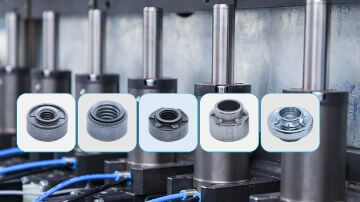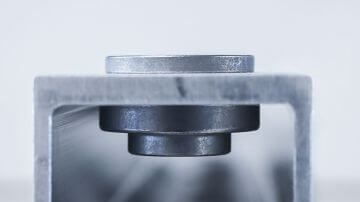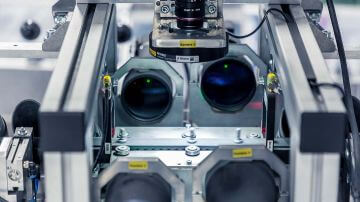
Rivet nut for high-strength sheet metal
Effective fastening solution for lightweight construction
Blog post | February 9, 2023
The use of high-strength sheet steel offers great potential for the future development of lighter and safer vehicles. Such sheets play a decisive role in reducing the weight of the vehicle body. Due to the high tensile and compressive strength, thinner sheet metal processing is possible, which leads to considerable weight savings in the vehicle. This has a positive effect on the energy efficiency of the vehicle and also helps to reduce CO₂ emissions.
When it comes to joining high-strength steel sheets, rivet nuts in particular are a superior solution for lightweight construction. They impress with their high tensile strength, making them the ideal choice for highly dynamic applications.
Contact us
Our customer service will help you with any questions!
Contents
- Properties of high-strength sheet steel
- Performance of the rivet nut
- Field of application of the rivet nut
- Rivet nut for lightweight construction
- Assembly of the rivet nut
- Requirements for vehicle components made from high-strength sheet steel
- Summary

Properties of high-strength sheet steel
High-strength steel grades have different properties depending on the proportions of carbon and other alloy components. High-strength steel is characterized by its extraordinary tensile strength. This allows the use of thinner sheets without compromising the stability of the structure.
This property is therefore particularly useful in applications where weight plays a role.
Despite the reduction in sheet thickness, the steel retains its required strength. This approach to weight reduction is a key factor in the design of vehicles, which need to be both efficient and safe.
High-strength steel also has good formability. Despite its strength, it remains flexible enough to absorb energy in the event of an impact, which also makes it an excellent choice for safety-related aspects in the vehicle.

Performance of the rivet nut
The rivet nut is an indispensable fastener when it comes to connections in high-strength sheet metal. Its torques and push-out forces are very high and are significantly higher than those of clinch nuts or self-piercing nuts. The nut is therefore suitable for a wide range of dynamic applications.
Thanks to its large diameter and height, the rivet nut is very resistant and can bear high loads from any direction. It is also able to withstand high lateral forces.
The large body of the rivet nut also enables a very high pulling force. The wedge under-head ribs ensure high torque absorption, especially in higher strength materials.
The rivet nut also enables high torsional resistance and push-out forces, even with thin sheet metal. This makes it an ideal choice for use in high-strength sheet metal.

Application range of the rivet nut
The rivet nut is particularly suitable for use in high-strength sheet metal with tensile strengths of 600 Mpa to 800 Mpa. This means it can also be used for sheet metal strengths that are beyond the application range of conventional clinch nuts or self-piercing nuts. Custom versions of the rivet nut can be used for high-strength sheet metal with tensile strengths of up to 1,400 Mpa.
The rivet nut can be used universally and does not require the geometry to be adapted for different sheet thicknesses. Thanks to its design, it can be used in a sheet thickness range from 0.7 mm to 2 mm. A special design of the rivet nut is used for thicker sheets 2 mm - 4 mm. This flexibility leads to a reduction in the number of variants of the nut, and therefore to lower storage costs. The riveted joint is also ideal for waterproof and gas-tight applications.

Rivet nut for lightweight construction
To enable high pull-through forces, the rivet nut is equipped with a large contact surface. However, the large nut dimensions also result in a heavier weight of the fastener. To compensate for this, the rivet nut is stepped. This gives it a large contact surface with optimum weight. In this way, the rivet nut can withstand high loads without being excessively heavy.
The stepped ATR rivet nut is ideal for lightweight construction applications. It has an oversized contact surface and also enables weight optimization thanks to its stepping. With an M8 nut, for example, this represents a weight saving of 33% compared to a standard rivet nut.

Assembly of the rivet nut
Standard rivet nut for sheet metal up to 800 Mpa
The rivet nut is inserted into a pre-punched pilot hole with embossing. It is stamped on the bottom of the sheet metal. The rivet collar is about 0.2 mm behind the bottom of the sheet. The rivet collar is formed and folded around the sheet. A special rivet die is used during installation, whereby either the rivet collar or the die is oiled. During this riveting process, the wedge ribs imprint themselves into the sheet metal, resulting in a very strong and durable connection.
The resulting connection between the rivet nut and the sheet metal has a high strength and pull-through force. The reasons for this are the highly tempered nut, the large and high nut dimensions and the regular preload that can be built up between the joined sheets.
No setting behavior is possible due to the large nut body. The rivet nut builds up a regular preload between the connected sheets during the subsequent screw connection. The preload built up ensures the highly load-bearing structural connection.
Special design of the rivet nut for sheets from 800 Mpa - 1400 Mpa
The rivet nut, which is used for high-strength sheet metal with tensile strengths from 800 Mpa, has a deformation collar instead of wedge ribbing. This deformation collar is used to absorb the torques. The assembly of the rivet nut remains unchanged, with the difference that a non-circular pre-punched pilot hole is made in the high-strength sheet metal and this is then embossed.

Requirements for vehicle components made of high-strength sheet steel
The requirements for sheet metal in a vehicle body are diverse and depend on the respective area of the vehicle. To save weight, the sheet metal must remain thin and light, but still be resistant. The material at the front and rear should be easily deformable in order to absorb energy as effectively as possible in the event of a collision. In contrast, the material used for the passenger cell must be extremely strong to ensure maximum occupant safety in the event of a collision.
High-strength steel is used for vehicle components that are essential for the stability of the vehicle, such as the B-pillar. The same applies to the side impact protection and front cross members, which play a decisive role in protecting the occupants. Sills and center tunnels reinforce the structure of the vehicle and also benefit from the high strength of the material. The roof frame and certain areas of the bulkhead are further examples of the use of high-strength steel.

Summary
The rivet nut is an essential fastener when working with high-strength sheet metal. With its exceptional performance, it is particularly resistant to high loads from all directions. It has excellent torque and push-out forces and enables a strong and durable connection.
The rivet nut is ideal for use in lightweight construction. Thanks to its optimized design, it contributes to reducing the weight of the vehicle body, just like the high-strength sheet metal. The rivet nut meets the highest requirements without having to make any changes to the fastener. High-strength sheet metal can be joined effectively and securely with rivet nuts.



